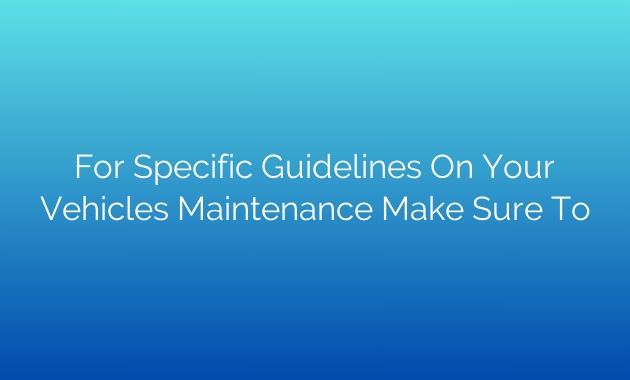Contents
- 1 For Specific Guidelines On Your Vehicle’s Maintenance, Make Sure To Follow These Steps
- 1.1 1. Read the Owner’s Manual
- 1.2 2. Regular Oil Changes
- 1.3 3. Check and Replace Filters
- 1.4 4. Inspect and Rotate Tires
- 1.5 5. Check and Maintain Fluid Levels
- 1.6 6. Inspect and Replace Worn-out Belts and Hoses
- 1.7 7. Battery Maintenance
- 1.8 8. Keep Your Vehicle Clean
- 1.9 9. Check and Maintain the Braking System
- 1.10 10. Regularly Inspect Lights and Wipers
- 1.11 Conclusion:
- 1.12 Frequently Asked Questions (FAQs)
For Specific Guidelines On Your Vehicle’s Maintenance, Make Sure To Follow These Steps
Your vehicle is an important investment that requires regular maintenance to ensure its optimal performance, longevity, and safety. By following specific guidelines for your vehicle’s maintenance, you can avoid costly repairs and keep your vehicle running smoothly. In this article, we will provide you with detailed information and expert advice on how to maintain your vehicle effectively.
1. Read the Owner’s Manual
The owner’s manual is the most comprehensive source for specific guidelines on maintaining your vehicle. It contains valuable information about maintenance schedules, recommended fluids, tire pressure, and more. Take the time to read and understand the manual to ensure you are following the manufacturer’s instructions.
2. Regular Oil Changes
One of the essential maintenance tasks for your vehicle is regular oil changes. Engine oil lubricates the engine and prevents wear and tear. Follow the manufacturer’s recommendations for the type of oil and the interval for oil changes.
3. Check and Replace Filters
Filters, such as the air and fuel filters, play a crucial role in maintaining your vehicle’s performance. Regularly inspect and replace these filters according to the manufacturer’s guidelines to ensure clean air intake and optimal fuel efficiency.
4. Inspect and Rotate Tires
Proper tire maintenance is vital for your vehicle’s safety and fuel efficiency. Regularly inspect your tires for any signs of wear, damage, or low tread depth. Rotate the tires as recommended by the manufacturer to promote even wear and extend their lifespan.
5. Check and Maintain Fluid Levels
Various fluids, including coolant, transmission fluid, and brake fluid, are essential for your vehicle’s proper functioning. Regularly check the fluid levels and top them up or replace them as needed. Refer to the owner’s manual for specific guidelines on each fluid type.
6. Inspect and Replace Worn-out Belts and Hoses
Belts and hoses play a critical role in various systems of your vehicle, such as the engine, cooling, and power steering. Regularly inspect these components for signs of wear, cracks, or leaks. Replace them promptly to prevent potential breakdowns or damage to other parts.
7. Battery Maintenance
Ensure your vehicle’s battery is in good condition by regularly checking its terminals for corrosion and cleaning them if necessary. Test the battery’s voltage and consider replacing it if it’s old or unreliable to avoid unexpected breakdowns.
8. Keep Your Vehicle Clean
Maintaining the cleanliness of your vehicle is not only for aesthetic purposes but also for its longevity. Regularly wash your vehicle, including the underCarriage, to remove dirt, salt, and other debris that can cause corrosion and damage to the paint and metal components.
9. Check and Maintain the Braking System
The braking system is vital for your safety on the road. Regularly inspect the brake pads, rotors, and brake fluid levels. Replace worn-out pads and damaged rotors and ensure the brake fluid is at the recommended level for optimal braking performance.
10. Regularly Inspect Lights and Wipers

Properly functioning lights and wipers are essential for your safety and visibility. Regularly inspect all exterior lights and replace any burnt-out bulbs. Check the condition of your windshield wipers and replace them if they are worn or not effectively clearing the windshield.
Conclusion:
In conclusion, following specific guidelines for your vehicle’s maintenance is crucial to ensure its optimal performance, longevity, and safety. By reading the owner’s manual, regularly changing oil, inspecting and replacing filters, maintaining fluid levels, caring for tires, checking belts and hoses, keeping the battery clean, washing the vehicle, maintaining the braking system, and inspecting lights and wipers, you can keep your vehicle in top condition.
Frequently Asked Questions (FAQs)
1. How often should I change my vehicle’s oil?
Refer to your vehicle’s owner’s manual for the manufacturer’s recommended oil change interval. Generally, it is advised to change the oil every 3,000 to 5,000 miles or every six months, whichever comes first.
2. Can I use any type of oil filter for my vehicle?
No, it is essential to use the oil filter specified by the vehicle manufacturer. Using the wrong filter may not fit correctly or provide the necessary filtration, potentially causing engine damage.
3. When should I replace my vehicle’s air filter?
The frequency of air filter replacement depends on various factors, such as driving conditions and the filter’s type. As a general guideline, it is recommended to replace the air filter every 12,000 to 15,000 miles, or as per the manufacturer’s instructions.
4. How often should I rotate my vehicle’s tires?
Tire rotation intervals vary depending on the vehicle’s make and model. As a general rule of thumb, it is recommended to rotate your tires every 5,000 to 7,000 miles or during every oil change.
5. What should I do if my vehicle’s battery is not holding a charge?
If your vehicle’s battery is not holding a charge, it may need to be replaced. Consult a professional mechanic who can test the battery and help you find the most suitable replacement for your vehicle.
